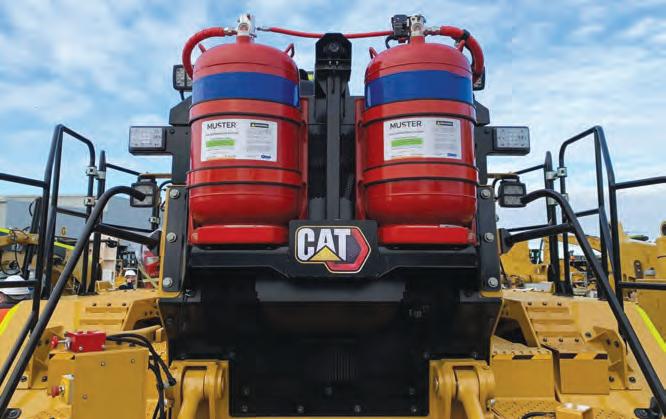
4 minute read
Advanced tech lights up fire suppression capability
THE MUSTER FIRE SUPPRESSION PRODUCT FROM JSG INDUSTRIAL SYSTEMS IS PAVING THE WAY FOR SAFER AND MORE RELIABLE OPERATIONS THROUGH RELIABLE AND ACCURATE SENSOR TECHNOLOGY.
The consequences of a fire starting at a mine site are catastrophic.
Fires can potentially lead to site-wide shutdowns, productivity losses – and in the most serious cases, fatalities.
While Australian mining operations require stringent fire safety measures, the risk of one occurring requires effective management and mitigation.
In 2019, 141 fires occurred on mobile plant at New South Wales mine sites alone, according to data from the NSW Resources Regulator.
JSG Industrial Systems combats this problem with the technologically advanced Muster fire suppression system.
The system is designed with intelligent sensors, including the MusterWire linear heat detection sensor and system pressure transducer.
This allows the system to constantly monitor plant and equipment to ensure mine operators have complete oversight and awareness of a potential fire.
JSG Industrial business development manager Dale Sharpe says the linear heat detection technology used on the Muster product is more reliable than traditional fire suppression methods.
“It’s very important to have a system that operates correctly,” Sharpe tells Safe to Work.
“One good thing about the Muster system is its use of linear heat detection technology.
“This means we have a lot less joins and hosing where the system could potentially leak from.”
The Muster system is also capable of detecting any faults during routine checks to speed up maintenance processes, which can prevent long stints of unwanted downtime at a mine site.
For Sharpe, a fire suppression system is vital to ensure the safety of a mine operation.
“Any fire system is what we refer to as a frontline safety system. It’s right at the forefront of keeping operators safe,” Sharpe says.
Since entering the fire industry, JSG has been a leader in the technological advances of fire suppression systems.
Muster exemplifies this development with its cloud-based Muster360 software, which allows users to design bespoke fire systems and complete full risk assessments that ensure the fire suppression system meets AS50622016 certification.
“Apart from a fire suppression system needing to work on a physical machine, a lot of paperwork is involved in the background to ensure the system is designed, installed and serviced correctly,” Sharpe says.
“Muster360 can achieve that by taking care of the paperwork involved with the compliance of a fire system.
“It also allows you to design a fire system for a specific machine and identify what is likely to cause it to catch fire through a risk assessment.”
Sharpe says the Muster fire suppression system can already be used for electric vehicle fires, but further enhancements and innovations are on the horizon in this area.
JSG offers technologically advanced fire suppression systems.
“Electric mining machines are developing at a rapid rate, which means that all manufacturers are having to develop new mediums, and that’s something the Muster team is also doing,” he says.
Muster fire suppression systems are used by major mining companies across Western Australia, which is made possible through JSG’s network of distribution partners such as fire services provider Paull & Warner Resources (PWR).
For around five years, JSG has worked with PWR to deliver the Muster systems to the market.
PWR installs, services and maintains Muster fire suppressions systems at mines across the Pilbara region.
“The business relationship has progressed very well with us as a service provider and them as an OEM (original equipment manufacturer) certified product supplier,” PWR fire technical services manager Brad McCallum says.
“The communication between us and JSG is very open, we engage very well with them when there are any issues or improvements or system changes that are required.”
PWR has grown to become JSG’s largest vendor in Australia as demand for Muster fire suppression systems increases.
“I think with the way that the relationship has been tracking and the support that we’ve been receiving from JSG over the last five years, it is a real testament to how well we are working together,” McCallum says.
McCallum says that mine site fires commonly occur from engine heat sources such as diesel engines and fuel sources.
He emphasises that without an effective fire suppression system, the cause of these fires can remain unknown.
“Miners that don’t use the Muster system may be missing out on the visibility of not only their

Fires commonly occur from engine heat sources such as diesel engines. Fire suppression systems are vital to ensure the safety of a mine operation.

fire systems but how their fleet is performing,” McCallum explains.
The Muster fire suppression system contains an alarm panel which delivers 24/7 monitoring and a diagnostics module that can display system pressure, battery status and system faults in real time.
McCallum says the diagnostics module is a key aspect of what puts the Muster system above the competition.
“If something does go wrong, such as a discharge event, the system can be interrogated at a higher level if an investigation needs to be undertaken,” McCallum says.
“It gives us the ability to have great visibility on assets and being able to look at historical information to give an accurate snapshot. We can find out why the system is discharging depending on a certain point of time.”
This provides peace of mind to mine operators by giving them understanding of how a fire started, which can prevent additional costs and downtime.
The Muster system’s diagnostics module also encourages safer industry practice by providing technicians with access to data regarding system faults and historical event logging following a system activation
“Following an emergency event, if you don’t have the ability to find out what’s happened and why a machine is down, it could lead to possible financial losses or worst-case scenario loss of life,” McCallum concludes.










